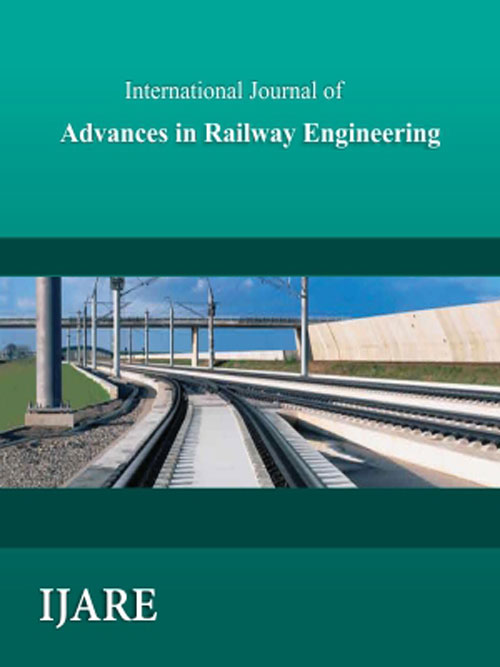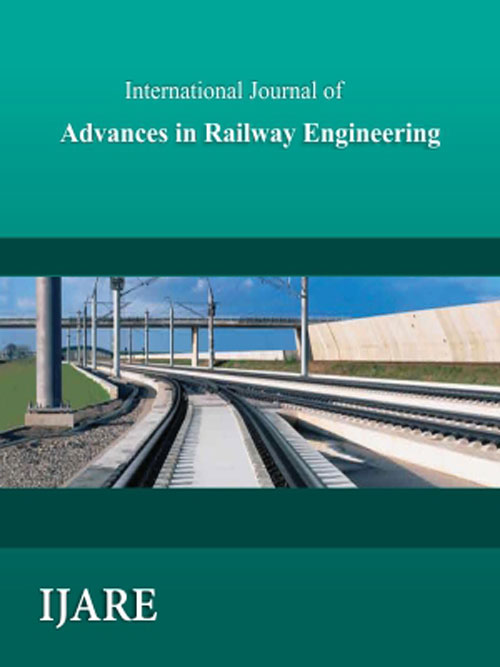فهرست مطالب

International Journal of Advances in Railway Engineering
Volume:1 Issue: 1, Autumn 2013
- تاریخ انتشار: 1392/08/01
- تعداد عناوین: 6
-
-
Page 1Three piece bogies are widely in use by the freight railway services throughout the world. In comparison with the other freight bogies they cost less and are easier to maintain. However, they do not exhibit favorable curving behavior. Amongst the methods to improve the bogie performance is the proposal to introduce lateral clearance in the bogies’ axleboxs. In the case of the three piece bogies, the lateral clearance has been used by some of the practicing engineers. It obviously added to the non-linear effects in the bogie tribological system and its dynamic performance. This study includes simulating the effects of the axlebox lateral clearance on hunting and curving behavior of the three pieces bogies. The effects of lubricating the rails at curves and adding to the track gauge are also investigated. The simulation is with the Universal Mechanism (UM) engineering software. It involves a loaded freight wagon equipped with two three piece bogies of type 18-100. Propositions are made in order to improve the vehicle dynamic performance and to decrease its maintenance costs.Keywords: axlebox clearance, vehicle lateral stability, three piece bogie (18, 100), coefficient of friction, wheel, rail friction work
-
Page 15In this research, the structural behavior of timber and concrete sleepers in a standard railway turnout is evaluated, in the case of raising speed. In approaching this evaluation, current practices in the structural analysis of sleepers are surveyed and then, the sensitivity analysis with ABAQUS software is made based on selected criteria (bending and shear stresses as well as contact pressure). Considering various sleepers with different dimensions in a turnout, two specific ones are selected as the representatives of moving (switch) and fixed (frog) parts. The results show that the maximum bending stress of timber sleeper compared to the concrete is reduced to about 55%, due to more flexibility. However, better behavior is resulted in concrete sleeper because of higher strength of materials. Meanwhile, the contact pressure between the timber sleeper and ballast layer is 80% higher which means that, the concrete sleeper provide better stress distribution for ballast materials. The effects of speed increase from 150 to 300 Km/hr also lead to an increase of about 30% in the stresses outputs.Keywords: Switch sleeper, speed, Structural Analysis, railway
-
Page 25The passenger line planning is a process of strategic long-term decision-making problem in the field of railway passenger planning. A line is a route between starting point and destination with certain stops, which has a certain frequency of train schedule. A new solution based on decomposition algorithm has been proposed in this paper, which is defined in a master problem and two sub problems. Since the solution provided by decomposition algorithm is not of the integer number type, a heuristic algorithm has been proposed for converting the results to integer numbers. The objective function for the line planning problem in this article is to maximize the number of direct passengers. Results on the proposed solution method, for the test problems, are compared to those of solutions generated via CPLEX software. Results show that the proposed solution method has high performance and accuracy. As a case study, optimized passenger railway lines in Iranian railway have been determined using the proposed algorithm.Keywords: railway transportation planning, passenger railway planning, line planning problem, decomposition algorithm
-
Page 37In this study, the performance of shred tire mixed with railway subgrade is evaluated to reduce environmental vibrations caused by trains’ passage. Since incorporating the Shred Tire seeds in soil affects on its shear strength and deformability parameters so, the first stage of the study was allocated to conducting a series of laboratory tests such as the unconfined compression test, and CBR and cyclic plate loading tests on the base material of GW-GC in combination of tire derived aggregates with particle size ranged from 0.475 to aggregation 2.5 cm in four various percentage of 0,5,10 and 15. Moreover, the cyclic plate loading tests were accomplished to determine the mixture elasticity modulus in the second loading cycle as Ev2.By using the obtained values of shear strength as well as deformability parameters obtained in the lab, a 2D numerical model of ballasted track was established under step loads corresponding to a passenger bogie. The numerical results showed that due to increase in shred tire percentage from 5 to 15 percent, the vertical vibration velocity at the ballast shoulder decrease up to 44.56 percent while this value reach to 44 percent for a point with 5 m distance from track shoulder. As a practical result an equation was proposed to show the relation between shred tire percentage and value of environmental vibration.Keywords: mix of shred tire, Subgrade, plate loading test, vibration caused by trains
-
Page 51In this article, multiple-product PVRP with pickup and delivery that is used widely in goods distribution or other service companies, especially by railways, was introduced. A mathematical formulation was provided for this problem. Each product had a set of vehicles which could carry the product and pickup and delivery could simultaneously occur. To solve the problem, two meta-heuristic methods, both based on particle swarm optimization, were provided and ran for small and large class problems and their efficiency were demonstrated. Also, efficiency of binary PSO to general PSO was tested and BPSO was shown to outperform the general method. This approach can be used in railway transportation.Keywords: periodic vehicle routing, particle swarm optimization, binary particle swarm optimization, railway
-
Page 61The vibrations produced by trains include two parts which are deterministic and random vibrations. Due to variation of dynamic loads and patterns of load-time, the random vibration of moving train is one of the most important issues in the field of railway engineering. One of the important sources in producing the train vibrations is rail roughness and irregularities. In this paper, responses of vehicle and railway components caused by half - bogie have been investigated. The model of moving vehicle on the railway track is considered as a half-bogie with two degrees of freedom. The connection elements between wheel and bogie are spring and damper. Also, model of railway system is considered as a beam on a rough surface. After modeling, equations of motion have been extracted for half-bogie and rail system. Then, motion equations of deterministic vibrations have been validated. The results indicated that the responses had good agreement with responses of previous studies. After validating, random equations have been presented in two domains that are time and frequency domains. For analyzing the random vibrations, track irregularity is applied as random, and power spectral densities are selected based on FRA organization. Analyses are performed based on half-bogie and railway parameters. The results have been presented for beam, sprung and un-sprung masses. Also, the results show that the maximum power spectral density of beam decreases with the increase of speed parameter.Keywords: Half, bogie model, Irregularity of railway track, Random vibrations, Power spectral density


